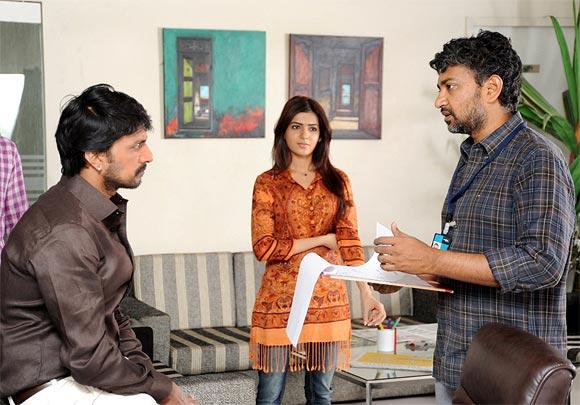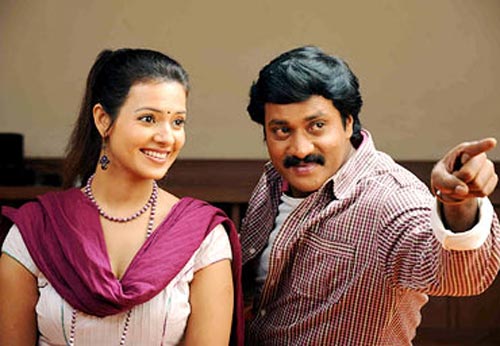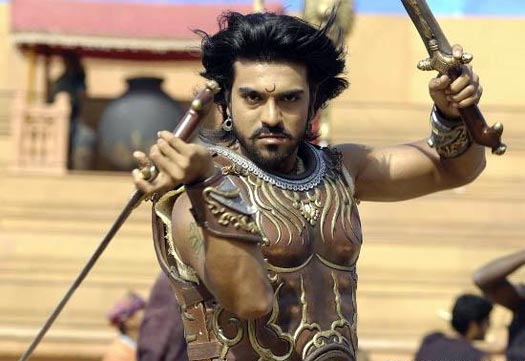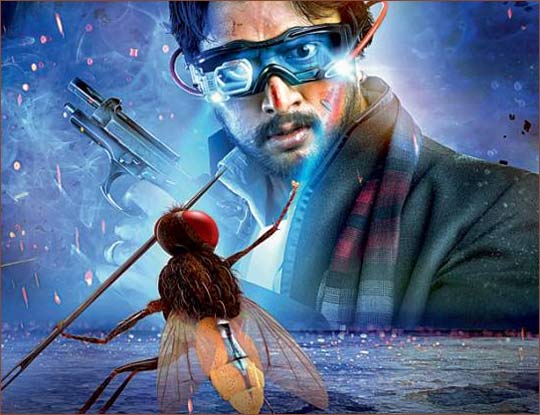Subhash K Jha in Patna
Makkhi director S S Rajamouli is all set to break into Hindi films. Makkhi is the Hindi dubbed version of his Telugu blockbuster Eega, about a fly who seeks revenge.
He discusses his plans to cross over to Bollywood with Subhash K Jha.
Is it true you have decided to take the plunge into Bollywood after Makkhi?
Yes. It will be a Hindi-Telugu film with a universal story, not star-centric film.
When I was in Mumbai for the promotion of Makkhi, I met Ajay Devgn, Kajol and Shah Rukh Khan. I wanted to meet Aamir Khan but he was shooting out of India. I also met my favourite director Rajkumar Hirani. All of them showered praise on Makkhi. I am now confident about attempting a film in Hindi. I believe if you have a good story to tell, audiences will watch it.
Whom would you like to work with?
It would have to be the Telugu actor Prabhas. We're committed to making the next film with him. I did work with Ajay Devgn and Kajol, who did the voiceover in Makkhi.
I wanted a couple with easily identifiable voices but with a family-oriented image. Ajay and Kajol fit the bill. Ajay agreed when I approached him but I insisted he see the film first. After watching the film, he said, 'I must show this film to my kids.'
I believe you've zeroed in on the subject that you want to do in Hindi?
Yes. I am looking at shooting my next film in Hindi and Telugu. It is a period film but not a historical. And no, it's not about reincarnation. I'm done with reincarnation after Magadheera and Eega.
'Rowdy Rathore was never offered to me'
Image: A scene from VikramarkurduWhat's this fascination with the theme of reincarnation?
It started with Rakesh Roshan's Karan Arjun. For the first time, I openly laughed and wept during a film. I was very reserved about my emotions earlier. Karan Arjun opened up my emotions.
Why have you stayed away from Hindi cinema?
Frankly, I did not get good offers until Eega. Now I'm flooded with offers. But I have some commitments to fulfil in the south before I head to Mumbai to make a film. Of course as a storyteller I want my cinema to reach a larger audience.
Your films have been remade and dubbed into several Indian languages. Yet, you continue to function from Andhra Pradesh.
I am very happy and proud to be known as a Telugu filmmaker. I am glad to know my films make a pan-India impact. I see no linguistic impediment. But to make a film in Hindi would be an advantage. It has to be a universal story like Makkhi. A fly is a fly anywhere. Vikramarkurdu was made as a star-vehicle for Ravi Tejaa. I couldn't have made it for the entire country. It was tailored for Telugu audiences.
Why didn't you direct Rowdy Rathore, the Hindi version of Vikramarkurdu?
Because it was never offered to me! And even it was, I wouldn't have done it. I'll be making an original film in Hindi. There is no point in doing the same film twice.
What did you think of Rowdy Rathore?
Frankly, I'm not a fan of my original Telugu film either. Yes, it had some good moments like the sentiments between the hero and the little girl who reforms him, which made the film work. The remakers exploited those moments but not enough. We gave much more footage in Vikramarkurdu to the father-daughter scenes.
'There is a very thin line between copying and adapting'
Image: A scene from Maryada RamannaThe refrain Chin tata chi tata in Rowdy Rathore was lifted from Vikramarkurdu and used into Rowdy Rathore.
Actually, that was not our original tune either. My music composer M M Kreem did not compose it. It is a folk tune in Tamil Nadu. It's a kind of anthem refrain among students in the state.Youngsters compose their own crude protest songs and then cap it with Chinta tata. It has existed in Tamil Nadu for generations. I made it a part of Ravi Teja's character and then it was given to Akshay Kumar.
Do you approve of filmmakers lifting secondary material?
There's a very thin line between copying and adapting. It's okay to use material from earlier films as long as it doesn't hurt the original creator.
Can you give me an example?
I've used scenes and shots inspired by earlier films in so many of my films. My film Maryada Ramanna (now remade as Son Of Sardar) was inspired by a 1923 Buster Keaton silent film Our Hospitality. One could say I copied the film, I don't mind. When I saw the original, I liked it so much I wanted to re-tell the same story in my way. I even tried to find the original creators but they died in the 1930s. Technically, any material that has existed for more than 75 years can be used without a copyright claim. But if you use material from a contemporary Punjabi, Oriya or Telugu film, you need permission.
What did you think of Akshay Kumar in Rowdy Rathore?
When I made my film, I made Ravi Teja pander to Telugu sensibilities. I think Prabhu Deva who directed the Hindi remake, made Akshay Kumar act according to the tastes of North Indian sensibilities. The two performances cannot be compared.
'Magadheera was my toughest film'
Image: A scene from MagadheeraNow your Maryada Ramanna turns your Telugu hero into a Sikh in Son Of Sardar.
I don't know what the cultural politics of Punjab are. But in one area of Andhra Pradesh, family feuds that persist for many generations is a reality. That's what I showed in Maryada Ramanna. I saw families that were perfectly cultured and courteous killing each other. Now you will have to tell me if such family feuds exist in Punjab. I don't think this peculiar contradictory culture of the co-existence of violence and hospitality exists in Punjab.
Even your other blockbuster Magadheera is being remade into Hindi. Why don't you direct it?
No, thanks. I have already spent two years of my life on it. I'd rather make something else. Magadheera was my toughest film. It was very tiring. The most satisfying film I've made is Maryada Ramanna. That's the only film I don't get bored watching. Eega (Makkhi) is my biggest hit to date.
How did you think of making a film with a fly as a hero?
It was there in my subconscious for a long time. My father was a well-known storywriter. He told me a story about a boy who was killed by the villain and was re-born as a fly. I wanted Eega (Makkhi) to be like a bedtime story.
The special effects in Makkhi are being compared with Hollywood films.
I'd like to thank one Kamal Kannan, a VFX producer who has worked with me in several films. I was confident about the visual effects because I had done them before. But animation was entirely new to me. All the animation technicians in my film were youngsters, in the 25-28 age group. Looking at them, you can't tell they are such high-calibre professionals. I'm proudest of the animation in Eega.
'Sudeep is the best actor I've worked with'
Image: Sudeep in EegaHow did the fly in Eega acquire its human personality?
We had to make sure the fly behaved the same way as the actor Naani, who dies and is born as a fly. The quality in Naani's personality had to be transferred to the fly. Once we got that in place, we had to work on the physical appearance of the fly.
In close-ups, a fly is ugly. At the same time, if we changed it, it would become a cartoon character. I have to thank (actor) Sudeep, who plays the fly's adversary for making the conflict look believable. He is the best actor I have worked with. The fly has no expressions. It is only through Sudeep's expressions that we know what the fly is up to.
What did your children think of Eega?
They loved it. My son and daughter constantly talk about films. I am getting worried. I feel I am pushing them prematurely into cinema.






Comment
article